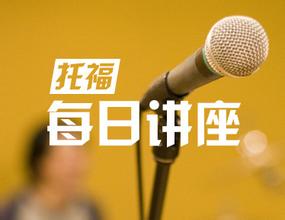 返回
教育头条
返回
教育头条

托福阅读考试原文及题目分享
在托福备考的过程中,考生一般都会拿TPO来进行托福考试的练习。因为其涵盖了大量托福考试的题型,能够帮助考生快速了解各类题型,从而更有针对性攻克自己的短板。今天小编为大家整理了托福阅读The Invention of the Mechanical Clock原文及题目,一起来了解一下吧!
The Invention of the Mechanical Clock
In Europe, before the introduction of the mechanical clock, people told time by sun (using, for example, shadow sticks or sun dials) and water clocks. Sun clocks worked, of course, only on clear days; water clocks misbehaved when the temperature fell toward freezing, to say nothing of long-run drift as the result of sedimentation and clogging. Both these devices worked well in sunny climates; but in northern Europe the sun may be hidden by clouds for weeks at a time, while temperatures vary not only seasonally but from day to night.
Medieval Europe gave new importance to reliable time. The Catholic Church had its seven daily prayers, one of which was at night, requiring an alarm arrangement to waken monks before dawn. And then the new cities and towns, squeezed by their walls, had to know and order time in order to organize collective activity and ration space. They set a time to go to sleep. All this was compatible with older devices so long as there was only one authoritative timekeeper; but with urban growth and the multiplication of time signals, discrepancy brought discord and strife. Society needed a more dependable instrument of time measurement and found it in the mechanical clock.
We do not know who invented this machine, or where. It seems to have appeared in Italy and England (perhaps simultaneous invention) between 1275 and 1300. Once known, it spread rapidly, driving out water clocks but not solar dials, which were needed to check the new machines against the timekeeper of last resort. These early versions were rudimentary, inaccurate, and prone to breakdown.
Ironically, the new machine tended to undermine Catholic Church authority. Although church ritual had sustained an interest in timekeeping throughout the centuries of urban collapse that followed the fall of Rome, church time was nature’s time. Day and night were divided into the same number of parts, so that except at the equinoxes, days and night hours were unequal; and then of course the length of these hours varied with the seasons. But the mechanical clock kept equal hours, and this implied a new time reckoning. The Catholic Church resisted, not coming over to the new hours for about a century. From the start, however, the towns and cities took equal hours as their standard, and the public clocks installed in town halls and market squares became the very symbol of a new, secular municipal authority. Every town wanted one; conquerors seized them as especially precious spoils of war; tourists came to see and hear these machines the way they made pilgrimages to sacred relics.
The clock was the greatest achievement of medieval mechanical ingenuity. Its general accuracy could be checked against easily observed phenomena, like the rising and setting of the sun. The result was relentless pressure to improve technique and design. At every stage, clockmakers led the way to accuracy and precision; they became masters of miniaturization, detectors and correctors of error, searchers for new and better. They were thus the pioneers of mechanical engineering and served as examples and teachers to other branches of engineering.
The clock brought order and control, both collective and personal. Its public display and private possession laid the basis for temporal autonomy: people could now coordinate comings and goings without dictation from above. The clock provided the punctuation marks for group activity, while enabling individuals to order their own work (and that of others) so as to enhance productivity. Indeed, the very notion of productivity is a by-product of the clock: once one can relate performance to uniform time units, work is never the same. One moves from the task-oriented time consciousness of the peasant (working on job after another, as time and light permit) and the time-filling busyness of the domestic servant (who always had something to do) to an effort to maximize product per unit of time.
考试题目:
Q1 Why does the author provide the information that "in northern Europe the sun may be hidden by clouds for weeks at a time, while temperatures vary not only seasonally but from day to night" ?
A. To emphasize the variety of environments in which people used sun and water clocks to tell time B. To illustrate the disadvantages of sun and water clocks C. To provide an example of an area where water clocks have an advantage over sun clocks D. To counter the claim that sun and water clocks were used all over Europe
Q2 According to paragraph 2, all of the following are examples of the importance of timekeeping to medieval European society EXCEPT:
A. the need of different towns to coordinate timekeeping with each other B. the setting of specific times for the opening and closing of markets C. the setting of specific times for the start and finish of the working day D. the regulation of the performance of daily church rituals
Q3 According to paragraph 2, why did the medieval church need an alarm arrangement?
A. The alarm warned the monks of discord or strife in the town. B. The church was responsible for regulating working hours and market hours. C. The alarm was needed in case fires were not put out each night. D. One of the church's daily rituals occurred during the night.

Q4 The word "authoritative" in the passage is closest in meaning to
A. actual B. important C. official D. effective
Q5 The author uses the phrase "the timekeeper of last resort" to refer to
A. water clocks B. the sun C. mechanical clocks D. the church
Q6 The word “rudimentary” in the passage is closest in meaning to
A. rare B. small C. impractical D. basic
Q7 According to paragraph 4, how did the Catholic Church react to the introduction of mechanical clocks?
A. Its used mechanical clocks through the period of urban collapse. B. It used clocks to better understand natural phenomena, like equinoxes. C. It tried to preserve its own method of keeping time, which was different from mechanical-clock time. D. It used mechanical clocks to challenge secular, town authorities.
Q8 The word "installed" in the passage is closest in meaning to?
A. required B. expected by the majority of people C. standardized D. put in place
Q9 It can be inferred from paragraph 5 that medieval clockmakers
A. were able to continually make improvements in the accuracy of mechanical clocks B. were sometimes not well respected by other engineers C. sometimes made claims about the accuracy of mechanical clocks that were not true D. rarely shared their expertise with other engineers
Q10 Paragraph 5 answers which of the following questions about mechanical clocks?
A. How did early mechanical clocks work? B. Why did the design of mechanical clocks affect engineering in general? C. How were mechanical clocks made? D. What influenced the design of the first mechanical clock?
The Invention of the Mechanical Clock
In Europe, before the introduction of the mechanical clock, people told time by sun (using, for example, shadow sticks or sun dials) and water clocks. Sun clocks worked, of course, only on clear days; water clocks misbehaved when the temperature fell toward freezing, to say nothing of long-run drift as the result of sedimentation and clogging. Both these devices worked well in sunny climates; but in northern Europe the sun may be hidden by clouds for weeks at a time, while temperatures vary not only seasonally but from day to night.
Medieval Europe gave new importance to reliable time. The Catholic Church had its seven daily prayers, one of which was at night, requiring an alarm arrangement to waken monks before dawn. And then the new cities and towns, squeezed by their walls, had to know and order time in order to organize collective activity and ration space. They set a time to go to sleep. All this was compatible with older devices so long as there was only one authoritative timekeeper; but with urban growth and the multiplication of time signals, discrepancy brought discord and strife. Society needed a more dependable instrument of time measurement and found it in the mechanical clock.
We do not know who invented this machine, or where. It seems to have appeared in Italy and England (perhaps simultaneous invention) between 1275 and 1300. Once known, it spread rapidly, driving out water clocks but not solar dials, which were needed to check the new machines against the timekeeper of last resort. These early versions were rudimentary, inaccurate, and prone to breakdown.
Ironically, the new machine tended to undermine Catholic Church authority. Although church ritual had sustained an interest in timekeeping throughout the centuries of urban collapse that followed the fall of Rome, church time was nature’s time. Day and night were divided into the same number of parts, so that except at the equinoxes, days and night hours were unequal; and then of course the length of these hours varied with the seasons. But the mechanical clock kept equal hours, and this implied a new time reckoning. The Catholic Church resisted, not coming over to the new hours for about a century. From the start, however, the towns and cities took equal hours as their standard, and the public clocks installed in town halls and market squares became the very symbol of a new, secular municipal authority. Every town wanted one; conquerors seized them as especially precious spoils of war; tourists came to see and hear these machines the way they made pilgrimages to sacred relics.
The clock was the greatest achievement of medieval mechanical ingenuity. Its general accuracy could be checked against easily observed phenomena, like the rising and setting of the sun. The result was relentless pressure to improve technique and design. At every stage, clockmakers led the way to accuracy and precision; they became masters of miniaturization, detectors and correctors of error, searchers for new and better. They were thus the pioneers of mechanical engineering and served as examples and teachers to other branches of engineering.
The clock brought order and control, both collective and personal. Its public display and private possession laid the basis for temporal autonomy: people could now coordinate comings and goings without dictation from above. The clock provided the punctuation marks for group activity, while enabling individuals to order their own work (and that of others) so as to enhance productivity. Indeed, the very notion of productivity is a by-product of the clock: once one can relate performance to uniform time units, work is never the same. One moves from the task-oriented time consciousness of the peasant (working on job after another, as time and light permit) and the time-filling busyness of the domestic servant (who always had something to do) to an effort to maximize product per unit of time.
考试题目:
Q1 Why does the author provide the information that "in northern Europe the sun may be hidden by clouds for weeks at a time, while temperatures vary not only seasonally but from day to night" ?
A. To emphasize the variety of environments in which people used sun and water clocks to tell time B. To illustrate the disadvantages of sun and water clocks C. To provide an example of an area where water clocks have an advantage over sun clocks D. To counter the claim that sun and water clocks were used all over Europe
Q2 According to paragraph 2, all of the following are examples of the importance of timekeeping to medieval European society EXCEPT:
A. the need of different towns to coordinate timekeeping with each other B. the setting of specific times for the opening and closing of markets C. the setting of specific times for the start and finish of the working day D. the regulation of the performance of daily church rituals
Q3 According to paragraph 2, why did the medieval church need an alarm arrangement?
A. The alarm warned the monks of discord or strife in the town. B. The church was responsible for regulating working hours and market hours. C. The alarm was needed in case fires were not put out each night. D. One of the church's daily rituals occurred during the night.

Q4 The word "authoritative" in the passage is closest in meaning to
A. actual B. important C. official D. effective
Q5 The author uses the phrase "the timekeeper of last resort" to refer to
A. water clocks B. the sun C. mechanical clocks D. the church
Q6 The word “rudimentary” in the passage is closest in meaning to
A. rare B. small C. impractical D. basic
Q7 According to paragraph 4, how did the Catholic Church react to the introduction of mechanical clocks?
A. Its used mechanical clocks through the period of urban collapse. B. It used clocks to better understand natural phenomena, like equinoxes. C. It tried to preserve its own method of keeping time, which was different from mechanical-clock time. D. It used mechanical clocks to challenge secular, town authorities.
Q8 The word "installed" in the passage is closest in meaning to?
A. required B. expected by the majority of people C. standardized D. put in place
Q9 It can be inferred from paragraph 5 that medieval clockmakers
A. were able to continually make improvements in the accuracy of mechanical clocks B. were sometimes not well respected by other engineers C. sometimes made claims about the accuracy of mechanical clocks that were not true D. rarely shared their expertise with other engineers
Q10 Paragraph 5 answers which of the following questions about mechanical clocks?
A. How did early mechanical clocks work? B. Why did the design of mechanical clocks affect engineering in general? C. How were mechanical clocks made? D. What influenced the design of the first mechanical clock?
如果大家通过上面的阅读,还想了解更多托福相关信息,可以关注我的微信18560125702,我会为你匹配最适的学习方案,选课有问题,快来找学姐,嘻嘻。返回教育宝头条
【免责声明】本文仅代表作者本人观点,与教育宝无关。教育宝对文中陈述、观点判断保持中立,不对所包含内容的准确性、可靠性或完整性提供任何保证。请读者仅作参考,特此声明!





